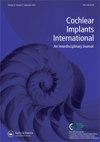AzBio Sentence test in Hebrew (HeBio): development, preliminary validation, and the effect of noise
IF 1.4
Q2 OTORHINOLARYNGOLOGY
引用次数: 4
Abstract
Objective The AzBio sentence test is widely used to assess speech perception pre- and post-cochlear implantation. This study created and validated a Hebrew version of AzBio (HeBio) and tested its intelligibility amidst background noise. Methods In Experiment 1, 1,000 recorded Hebrew sentences were presented via five-channel vocoder to 10 normal hearing (NH) listeners for intelligibility testing. In Experiment 2, HeBio lists were presented to 25 post-lingual cochlear implant (CI) users amidst four-talker babble noise (4TBN) or in quiet, along with one-syllable word test. In Experiment 3, 20 NH listeners were presented with eight HeBio lists in two noise conditions [4TBN, speech shaped noise (SSN)] and four SNRs (+3, 0 dB, −3 dB, −6 dB). Results HeBio lists (33) produced 82% average understanding, no inter-list intelligibility differences among NH, and equal intelligibility for CI users. One-syllable words predicted 67% of the variance in HeBio among CI users. Higher intelligibility was found for SSN than for 4TBN, and the mean speech receptive threshold (SRT) was more negative for SSN than for 4TBN. Conclusions HeBio results were similar to AzBio. Results obtained with two noise types were as expected. HeBio is recommended for evaluation of different populations in quiet and noise.希伯来语AzBio句子测试(HeBio):发展、初步验证和噪音的影响
目的AzBio语句测试广泛用于评估人工耳蜗植入前后的言语感知。这项研究创建并验证了希伯来语版本的AzBio(HeBio),并测试了其在背景噪声中的可懂度。方法在实验1中,通过五声道声码器向10名正常听力(NH)听众呈现1000个记录的希伯来语句子,进行可懂度测试。在实验2中,将HeBio列表与单音节单词测试一起呈现给25名舌后耳蜗植入(CI)用户,这些用户处于四语者牙牙学语噪声(4TBN)或安静中。在实验3中,在两种噪声条件[4TBN,语音成形噪声(SSN)]和四种SNR(+3,0 dB,−3 dB,−6 dB)。结果HeBio列表(33)的平均理解率为82%,NH之间的列表间可懂度没有差异,CI用户的可懂度相同。单音节词预测了HeBio在CI用户中67%的方差。发现SSN的可懂度高于4TBN,并且SSN的平均语音接收阈值(SRT)比4TBN更负。结论HeBio结果与AzBio相似。使用两种噪声类型获得的结果与预期的一样。HeBio被推荐用于评估安静和噪音中的不同人群。
本文章由计算机程序翻译,如有差异,请以英文原文为准。
求助全文
约1分钟内获得全文
求助全文
来源期刊

COCHLEAR IMPLANTS INTERNATIONAL
Medicine-Otorhinolaryngology
CiteScore
3.10
自引率
0.00%
发文量
29
期刊介绍:
Cochlear Implants International was founded as an interdisciplinary, peer-reviewed journal in response to the growing number of publications in the field of cochlear implants. It was designed to meet a need to include scientific contributions from all the disciplines that are represented in cochlear implant teams: audiology, medicine and surgery, speech therapy and speech pathology, psychology, hearing therapy, radiology, pathology, engineering and acoustics, teaching, and communication. The aim was to found a truly interdisciplinary journal, representing the full breadth of the field of cochlear implantation.
 求助内容:
求助内容: 应助结果提醒方式:
应助结果提醒方式:


